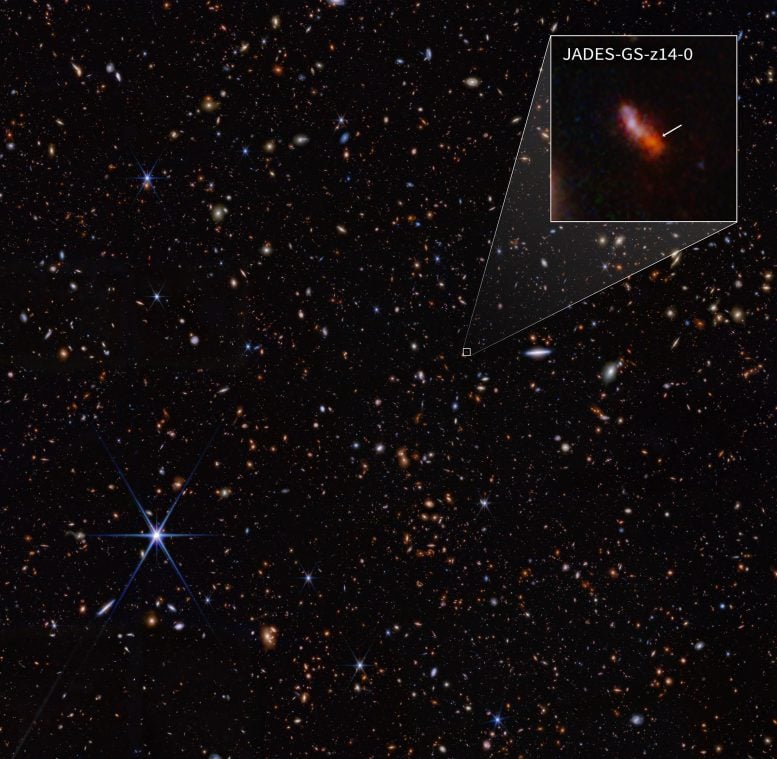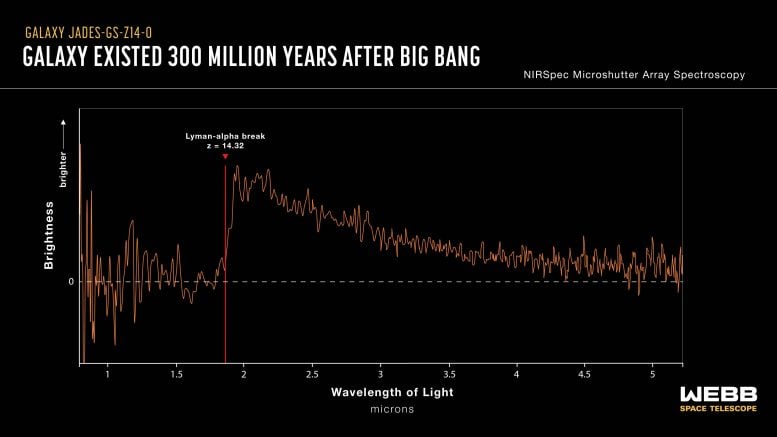
This infrared image from NASA’s James Webb Space Telescope (also called Webb or JWST) was taken by NIRCam (Near-Infrared Camera) for the JWST Advanced Deep Extragalactic Survey, or JADES, program. NIRCam data was used to determine which galaxies to study further with spectroscopic observations. One of these galaxies, JADES-GS-z14-0 (shown in the excerpt), was determined to be at a redshift of 14.32 (+0.08/-0.20), making it the current record holder for the most distant known galaxy. This corresponds to a time less than 300 million years after the Big Bang. Credits: NASA, ESA, CSA, STScI, Brant Robertson (UC Santa Cruz), Ben Johnson (CfA), Sandro Tacchella (Cambridge), Phill Cargile (CfA)
Astronomers use
” data-gt-translate-attributes=”({“attribute”:”data-cmtooltip”, “format”:”html”})” tabindex=”0″ role=”link”>NASAIt is
” data-gt-translate-attributes=”({“attribute”:”data-cmtooltip”, “format”:”html”})” tabindex=”0″ role=”link”>James Webb Space Telescope discovered the oldest and most distant galaxies known, dating back just 300 million years after the
” data-gt-translate-attributes=”({“attribute”:”data-cmtooltip”, “format”:”html”})” tabindex=”0″ role=”link”>Big Banga major step in understanding the early stages of the universe.
An international team of astronomers has announced the discovery of the two oldest and most distant galaxies yet confirmed, dating back just 300 million years after the Big Bang. This important discovery, made using NASA’s James Webb Space Telescope (JWST), marks a major milestone in the study of the early universe. These galaxies were discovered by the JWST Advanced Deep Extragalactic Survey (JADES) team, co-led by UC Santa Cruz astronomer Brant Robertson.
“This discovery is completely unexpected and is likely to be considered the most important extragalactic discovery with JWST to date,” said Robertson, a professor of astronomy and astrophysics who serves on the JADES steering committee. He is the lead author of the first of three papers reporting various aspects of the discovery.
In a paper, the authors conclude: “This demonstrates the immediate impact that the new JWST observations can have on our knowledge of the distant universe. With populations of high-redshift galaxies now established less than 300 million years after the Big Bang, we have extended our reach into the cosmic past by 40% during the first eighteen months of JWST operations.
“Redshift” refers to an effect caused by the expansion of the universe, where the wavelength of light from distant galaxies expands as it travels. In these newly discovered galaxies, the effect is extreme: it expands by a factor of 15 and even shifts ultraviolet light from galaxies to infrared wavelengths where only JWST has the ability to see it.

Scientists used the Near-Infrared Spectrograph (NIRSpec) on NASA’s James Webb Space Telescope to obtain a spectrum of the distant galaxy JADES-GS-z14-0 to precisely measure its redshift and thus determine its age. The redshift can be determined from the location of a critical wavelength known as the Lyman-alpha break. This galaxy dates back less than 300 million years after the Big Bang. Credit: NASA, ESA, CSA, Joseph Olmsted (STScI), S. Carniani (Scuola Normale Superiore), JADES Collaboration
In pursuit of the first galaxies
Modern theory holds that galaxies grow in special regions where gravity has concentrated cosmic gas and dark matter into dense clusters called “halos.” These halos evolve rapidly in the early universe, coalescing into increasingly massive collections of matter. This rapid development explains why astronomers are so eager to discover even older galaxies: each small increment shifts our eyes to a less developed period, where the brightest galaxies are even more distinctive and unusual.
Found in a region near the Hubble Ultra Deep Field, the two newly discovered galaxies were confirmed spectroscopically. Following the collaboration’s standard naming practice, the galaxies are now known as JADES-GS-z14-0 and JADES-GS-z14-1, with the former being the more distant of the two.
In addition to being the new distance record holder, JADES-GS-z14-0 is remarkable for its size and brightness. JWST measures the galaxy more than 1,600 light years across. Most of the most luminous galaxies produce most of their light via gas falling in supermassive space.
” data-gt-translate-attributes=”({“attribute”:”data-cmtooltip”, “format”:”html”})” tabindex=”0″ role=”link”>black hole, producing a quasar. But the team says the large size of JADES-GS-z14-0 means the light must be produced by young stars.
Deeply hidden gems
And yet this massive galaxy was a headache for the JADES team when they first spotted it over a year ago, because it appears close enough in a galaxy’s sky at first plan so they couldn’t be sure the two weren’t neighbors. But in October 2023, the JADES team carried out even more in-depth imaging – five full days with the JWST near-infrared camera on a single field – to form the “JADES Origins field”. Through the use of filters designed to better isolate early galaxies, confidence grew that JADES-GS-z14-0 was indeed very distant.
Additionally, the galaxy was in a region where the team had conducted ultra-deep imaging with the JWST Mid-InfraRed instrument. These combined imaging results convinced the team to include the galaxy in what was to be the final observation of JADES, a 75-hour campaign aimed at performing spectroscopy on the first faint galaxies. The spectroscopy confirmed their hopes that JADES-GS-z14-0 was indeed a record galaxy and that the faintest candidate, JADES-GS-z14-1, was almost as far away.
A new era in cosmic exploration
The combination of high luminosity and stellar origin makes JADES-GS-z14-0 the most distinctive evidence to date of the rapid formation of large, massive galaxies in the early universe. “We could have detected this galaxy even if it was 10 times fainter, which means we could see other examples of it even earlier in the universe, probably within the first 200 million years,” said Robertson. “This galaxy is truly a gem and reveals other hidden treasures in the early universe.”
Robertson’s article, “Earliest Galaxies in the JADES Origins Field: Luminosity Function and Cosmic Star-Formation Rate Density 300 Myr after the Big Bang,” is accepted for publication in the
Source link